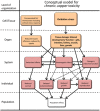Adverse Outcome Pathways for Chronic Copper Toxicity to Fish and Amphibians
- PMID: 36148934
- PMCID: PMC9828004
- DOI: 10.1002/etc.5483
Adverse Outcome Pathways for Chronic Copper Toxicity to Fish and Amphibians
Abstract
In the present review, we synthesize information on the mechanisms of chronic copper (Cu) toxicity using an adverse outcome pathway framework and identify three primary pathways for chronic Cu toxicity: disruption of sodium homeostasis, effects on bioenergetics, and oxidative stress. Unlike acute Cu toxicity, disruption of sodium homeostasis is not a driving mechanism of chronic toxicity, but compensatory responses in this pathway contribute to effects on organism bioenergetics. Effects on bioenergetics clearly contribute to chronic Cu toxicity with impacts at multiple lower levels of biological organization. However, quantitatively translating these impacts into effects on apical endpoints such as growth, amphibian metamorphosis, and reproduction remains elusive and requires further study. Copper-induced oxidative stress occurs in most tissues of aquatic vertebrates and is clearly a significant driver of chronic Cu toxicity. Although antioxidant responses and capacities differ among tissues, there is no clear indication that specific tissues are more sensitive than others to oxidative stress. Oxidative stress leads to increased apoptosis and cellular damage in multiple tissues, including some that contribute to bioenergetic effects. This also includes oxidative damage to tissues involved in neuroendocrine axes and this damage likely alters the normal function of these tissues. Importantly, Cu-induced changes in hormone concentrations and gene expression in endocrine-mediated pathways such as reproductive steroidogenesis and amphibian metamorphosis are likely the result of oxidative stress-induced tissue damage and not endocrine disruption. Overall, we conclude that oxidative stress is likely the primary driver of chronic Cu toxicity in aquatic vertebrates, with bioenergetic effects and compensatory response to disruption of sodium homeostasis contributing to some degree to observed effects on apical endpoints. Environ Toxicol Chem 2022;41:2911-2927. © 2022 The Authors. Environmental Toxicology and Chemistry published by Wiley Periodicals LLC on behalf of SETAC.
Keywords: Adverse outcome pathway; copper; endocrine disruption; mode of action; oxidative stress.
© 2022 The Authors. Environmental Toxicology and Chemistry published by Wiley Periodicals LLC on behalf of SETAC.
Figures




Similar articles
-
Toxicity mechanisms and bioavailability of copper to fish based on an adverse outcome pathway analysis.J Environ Sci (China). 2023 May;127:495-507. doi: 10.1016/j.jes.2022.06.002. Epub 2022 Jun 10. J Environ Sci (China). 2023. PMID: 36522080
-
Sensitivity of Amphibians to Copper.Environ Toxicol Chem. 2021 Jul;40(7):1810-1821. doi: 10.1002/etc.5049. Epub 2021 May 6. Environ Toxicol Chem. 2021. PMID: 33749926 Review.
-
A Generalized Bioavailability Model (gBAM) for Predicting Chronic Copper Toxicity to Freshwater Fish.Environ Toxicol Chem. 2020 Dec;39(12):2424-2436. doi: 10.1002/etc.4806. Epub 2020 Nov 5. Environ Toxicol Chem. 2020. PMID: 32573793
-
Critical Review of Read-Across Potential in Testing for Endocrine-Related Effects in Vertebrate Ecological Receptors.Environ Toxicol Chem. 2020 Apr;39(4):739-753. doi: 10.1002/etc.4682. Epub 2020 Mar 4. Environ Toxicol Chem. 2020. PMID: 32030793 Free PMC article. Review.
-
Mortality, bioaccumulation and physiological responses in juvenile freshwater mussels (Lampsilis siliquoidea) chronically exposed to copper.Aquat Toxicol. 2013 Jan 15;126:137-47. doi: 10.1016/j.aquatox.2012.10.014. Epub 2012 Oct 31. Aquat Toxicol. 2013. PMID: 23183413
Cited by
-
Curcumin's role in reshaping the redox dynamics of fish kidneys: NRF2 activation as a strategy against copper-induced nephropathy.Fish Physiol Biochem. 2025 May 7;51(3):94. doi: 10.1007/s10695-025-01506-x. Fish Physiol Biochem. 2025. PMID: 40332669
-
Captivating Colors, Crucial Roles: Astaxanthin's Antioxidant Impact on Fish Oxidative Stress and Reproductive Performance.Animals (Basel). 2023 Oct 29;13(21):3357. doi: 10.3390/ani13213357. Animals (Basel). 2023. PMID: 37958112 Free PMC article. Review.
-
Exposure to Rice Straw Ash Alters Survival, Development and Microbial Diversity in Amphibian Tadpoles.Ecol Evol. 2025 Jul 25;15(7):e71801. doi: 10.1002/ece3.71801. eCollection 2025 Jul. Ecol Evol. 2025. PMID: 40718695 Free PMC article.
-
Antagonistic Effect of Zinc Oxide Nanoparticles Dietary Supplementation Against Chronic Copper Waterborne Exposure on Growth, Behavioral, Biochemical, and Gene Expression Alterations of African Catfish, Clarias gariepinus (Burchell, 1822).Biol Trace Elem Res. 2024 Dec;202(12):5697-5713. doi: 10.1007/s12011-024-04115-6. Epub 2024 Feb 28. Biol Trace Elem Res. 2024. PMID: 38416342
-
Effects of Dietary Phytol Supplementation on Growth Performance, Immunological Parameters, Intestinal Bacteria, and Prevention of Oxidative Stress Following Transportation of Nile Tilapia, Oreochromis niloticus.Aquac Nutr. 2024 Feb 7;2024:7039179. doi: 10.1155/2024/7039179. eCollection 2024. Aquac Nutr. 2024. PMID: 39555567 Free PMC article.
References
-
- Allen, G. R. (1991). Oxygen reactive species and antioxidant responses during development: The metabolic paradox of cellular differentiation. Proceedings of the Society for Experimental Biology and Medicine, 196, 117–129. - PubMed
-
- Ankley, G. T. , Bennett, R. S. , Erickson, R. J. , Hoff, D. J. , Hornung, M. W. , Johnson, R. D. , Mount, D. R. , Nichols, J. W. , Russom, C. L. , Schmieder, P. K. , Serrano, J. A. , Tietge, J. E. , & Villeneuve, D. L. (2010). Adverse outcome pathways: A conceptual framework to support ecotoxicology research and risk assessment. Environmental Toxicology and Chemistry, 29, 730–741. - PubMed
-
- Anni, I. S. A. , Zebral, Y. D. , Afonso, S. B. , Abril, S. I. M. , Lauer, M. M. , & Bianchini, A. (2019). Life‐time exposure to waterborne copper III: Effects on the energy metabolism of the killifish Poecilia vivipara . Chemosphere, 227, 580–588. - PubMed
-
- Baldisserotto, B. , Mancera, J. M. , & Kapoor, B. G. (2007). Fish osmoregulation. Science Publishers.
-
- Baldwin, D. H. , Sandahl, J. F. , Labenia, J. S. , & Scholz, N. L. (2003). Sublethal effects of copper on coho salmon: Impacts on nonoverlapping receptor pathways in the peripheral olfactory nervous system. Environmental Toxicology and Chemistry, 22, 2266–2274. - PubMed
Publication types
MeSH terms
Substances
LinkOut - more resources
Full Text Sources

